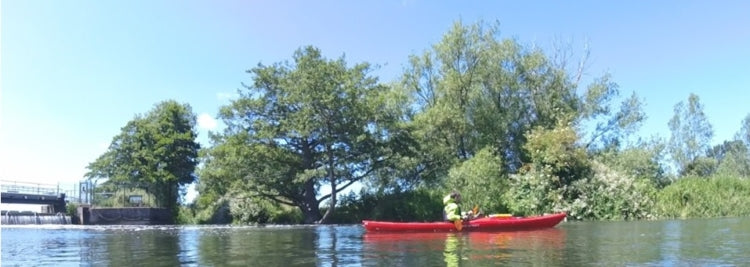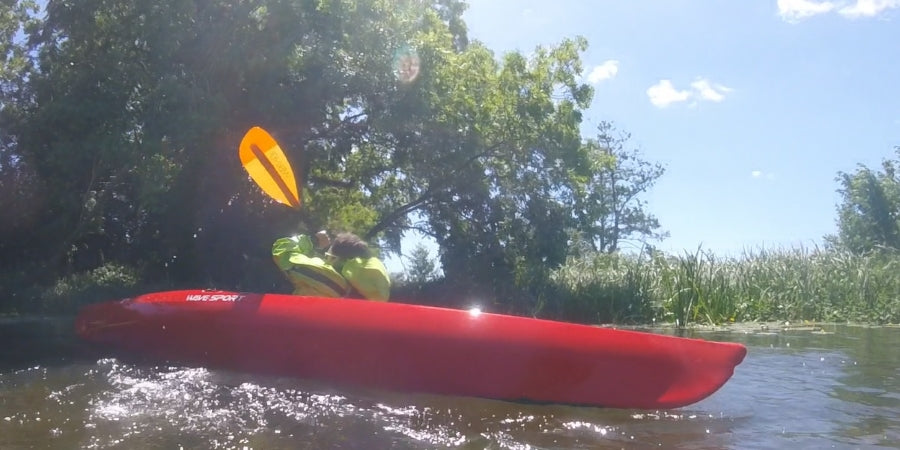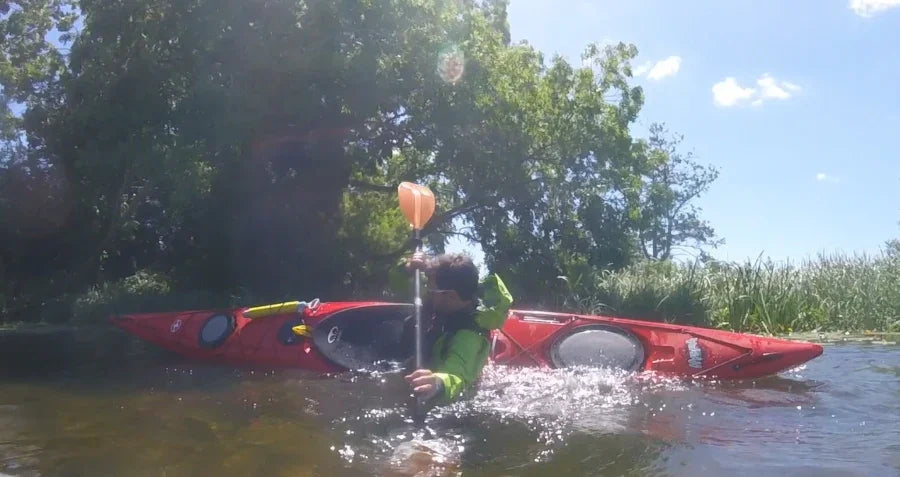First Impressions
Taking a first look at the Wave Sport Hydra the first thing you are drawn to is the Core WhiteOut seating system that Wave Sport have incorporated in to this kayak, it looks so comfortable and is bright white. Sitting in the Hydra it doesn’t disappoint either, the seat pad and back band are plenty padded and feel great. The ratchet adjustable leg lifter on the base of the seat is a great feature, allowing you as the paddler to get a greater lock into the Hydra. Wave Sport kit the Hydra out with the Core Whiteout hip pads with the flip out flap for more comfortable portaging with the kayak on your shoulder. The foot pegs are standard adjustable foot pegs and thigh braces are both adjustable as you would expect with most touring kayaks.
The cockpit of the Hydra is a little larger than I thought it would be which is good in one way as this allows more room for the paddler to get in and out easily. However for me personally being a ‘vertically challenged paddler’ (169cm) it means from in the seating position to reach the front day hatch is a slight stretch. The other thing I noticed with my height is that I have to pull the foot pegs all the way back as far as they will go, even then it is still for my personal preferred paddling position not quite close enough for me to get that great locked in feel I would like.

The weight of the Hydra is billed at 24kg (52.91lbs) which for a 4.52m (14.8ft) roto moulded plastic kayak made from quality plastic and fixings is quite light. I didn’t have any problems lifting the Hydra around or loading on and off the small van we have. I think most paddlers would be happy to lift & portage this kayak over short distances and should find loading and unloading fairly easy.

From the deck side of things the hydra offers 3 hatches with rubber hatch covers, 1 circular bow hatch, 1 oval hatch in the stern, both with sealed bulkheads and 1 smaller day hatch just in front of the paddler for things you might need close to hand while on the water. Wave Sport have put 2 Yak Attack geartrac rails on the back deck of the kayak allowing mounting of most accessories like go pros, etc. A large security grab rail just behind the seat is ideal for locking the Hydra when needed and unlike other manufacturers security points this one is plenty big enough to fit a range of locks through. Deck bungees and reflective deck lines give enough points to secure any further kit you want on the deck safely. Bow and stern carry handles secured with bungees to stop any flapping around finish the deck side of the Wave Sport Hydra well.

Wave Sport have put a different skeg adjustment system on the Hydra, this deployment and adjustment system has a push button on a slider to deploy and a push forward retraction system that you can here click as it comes back up. This click allows fine trimming of the amount of skeg you have deployed and will help in a range of weather conditions. This is a really nice addition to the Hydra and is nicer to use than the normal jam cleat you normally find on touring kayaks.
From the hull side of things I was interested like most people to see what has more rocker the Wave Sport Hydra or the Dagger Startos, as let’s be honest that is who Wave Sport are going up against selling this kayak. The rocker of the Hydra is much less than the rocker of the Stratos both large and small, this immediately changed my thoughts on this kayak. Rather than it going up against the Stratos it’s now offering another option for paddlers. Currently if you want a 15ft plastic kayak to do some touring and a little bit of playing in the surf your choice is really limited to the Dagger Stratos which is more set up towards play & surf than touring. However with the less rocker on the Hydra it offers a kayak that is set up to tour first and foremost with some surf and play as a secondary feature. Another thought is how well will the Hydra spin even with a slight negative edge, will it actually feel playful or not? The chines or rails on the Hydra start around a 3rd of the way down the hull and extend almost right to the back of the kayak which should allow for some good feedback from the hull of the Hydra when edging.
On the water...
Getting the Hydra on the water I was excited to put it through its paces and see what it could do. I was first of all impressed with just how stable on the water this kayak felt, normally I personally like to fine the limits of the kayak quickly so I know how far I can push it. However in the Hydra I didn’t bother as I knew instantly from feedback I was getting. I think this would give most paddlers confidence in the kayak as soon as they’re on the water. I did a little stand up test on the Hydra (we don’t recommend you do this) I found I could stand up in the kayak without feeling too unstable, which for me was proof enough that the Hydra hull offers great stability.

On to the next tests, from a still start the Hydra offers good acceleration both with the skeg up and skeg down. I found that the Hydra picks up speed quickly and reaches an easy cruising speed without too much effort and with no fuss. With the skeg fully deployed it helps with straight line tracking, but this would only be needed in poor conditions as the Hydra tracks well with the skeg retracted. Paddling along then initiating a slight negative edge while stopping paddling the Hydra turns easily and quite quickly, with a couple of forward paddles strokes and a negative edge back the other way, no problems and back you go the other way without feeling like the Hydra is trying to trip you up and cause you a capsize. A full 360 degree spin with no edging at all took around 10 paddle strokes which is what I would expect from a long touring kayak. A 180 degree turn with edging was 3-4 paddle strokes and was actually easy considering the Hydra has only slight rocker.

Skulling and high braces I did a good amount of this as I find it tells you a lot about the stability, limits and abilities of the kayak. I was able to hold the Hydra on edge, without any support from the paddle. I felt that you could feel where the limit was on the edge of the Hydra and you could hold it just before this or right on/slightly over the edge with a support stroke from the paddle.


Rolling and rescuing. I found rolling the Wave Sport Hydra quite easy, even with the Hydra not being perfectly fitted to me, as I had not adjusted the thigh braces to fit me properly. It felt like the Hydra wanted to continue rolling up once you had initiated the roll and got to the mid phase.

Rescuing from a wet exit in deep water I also found easy. The large cockpit, even though I am not a massive fan of this, does make exiting the kayak while upside down under the water easy. Plenty of room and nothing that you can get caught on, other than like all touring kayaks the foot pegs if you’re wearing certain types of footwear. Lifting the front of the kayak drains most of the water from the cockpit and its light enough to spin right side up while in deepwater. My preferred method for re-entry is to straddle the back deck, the deck lines help as a point to grip when you’re pulling yourself up on to the back. The easiest place I found to do this from on the Hydra was from the rear deck from just next to the rear oval hatch. When straddled over the back deck and shuffling up to just behind the seat with feet in the water either side, the Hydra didn’t even wobble. The next step of getting both feet and legs into the cockpit and settling into the seat is the part where most paddlers will potentially end up back in the water. I did this as quickly as I normally would to start with and found I was back in the seat before I knew it. Too easy was my first thought, that is not a bad thing though, so I tried again. This time I tried it slowly one leg then the other and it still felt solid which impressed me.

On my route back I cruised along without really doing much in the way of testing the Hydra, just enjoying the great weather and being out on the water, I guess what you would call a regular paddling. I thought nothing more of this, other than it was as I would expect from a touring kayak of this size, relatively effortless and a breeze to paddle. That was until I watched some of the video footage back of me paddling past, in this clip I personally think I was moving along rather quickly with a relaxed paddle stroke not really using a lot of energy at all.
Do I have any issues with the Wave Sport Hydra? The only issues I personally have with the design of the Hydra are from a personal point of view. I would have liked Wave Sport to think about the smaller, shorter paddlers and mount the foot peg runners slightly further back towards the seat to allow for a better fit. Also I still think that the cockpit is slightly too big, although I do understand that paddlers that are bigger than myself will need that extra cockpit space for easier entry and exit. I just found that the placement of the seat, foot pegs and size of the cockpit meant the day hatch was too far away from me, so I had to stretch to get things that had moved to the front of the day hatch.
That said overall I was impressed with Wave Sport Hydra on the whole both on and off the water and I can see that there really is a gap in the market for this kayak. If you’re a paddler wanting a comfortable kayak that is a touring kayak first and a play/surf kayak second for that occasional bit of playful fun the Hydra is perfect and highly recommended.
Reviewed by Luke at Norfolk Canoes
Full details on the Wavesport Hydra, and details on how to buy, can be found on our website here: Wavesport Hydra
Main FeaturesCORE WhiteOut Spec:
|
DimensionsLength: 14'10" / 452cm |

